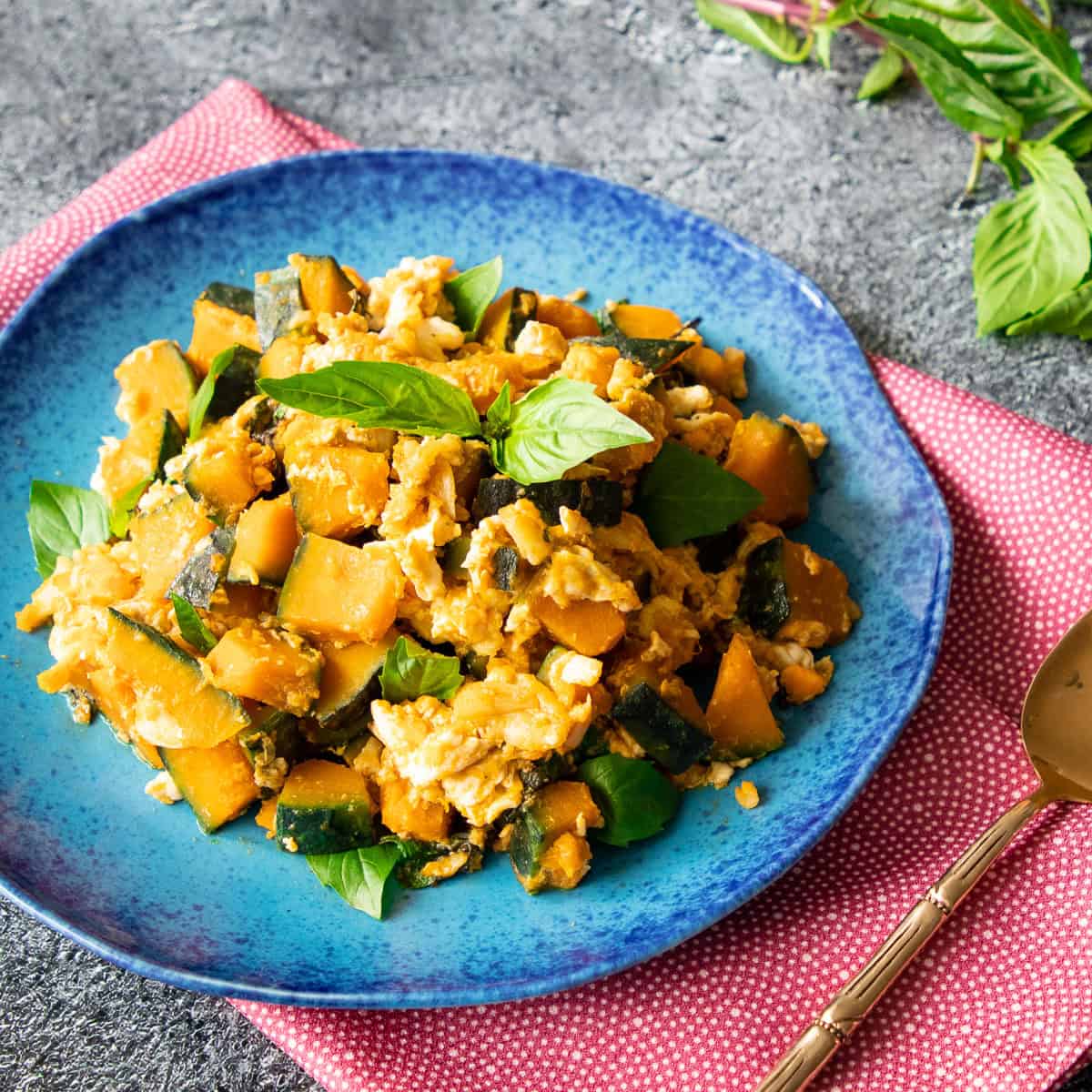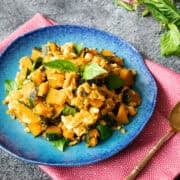One of my favourite dishes growing up is kabocha squash stir fry with scrambled eggs and Thai basil. In Western culture, squash is used for many things but rarely a stir fry, but it really is a fantastic way to do it! Kabocha squash is creamier, sweeter than butternut squash, and bonus: you don't have to peel it!

Want to save this recipe?
What is Faktong Pad Kai?
Faktong pad kai ฟักทองผัดไข่ is a stir fry of creamy sweet squash with eggs and Thai basil. Sometimes it's called pad faktong which simply means "stir fried pumpkins," which theoretically can mean any kind of stir fried pumpkin, but this egg and Thai basil version is the most common.
It is one of the most rustic Thai dishes that people often make at home, but it's also a common dish in raan khao gaeng, places that sell curries, stir fries, and other dishes all ready-made, and all you have to do is point to what you want the they will scoop it over a plate of rice.
In Thailand we typically use Thai pumpkins for this dish, but here I use kabocha squash which have a flavour and texture that's basically the same as Thai pumpkins. Thai pumpkins are much larger, so they're often sold pre-cut in smaller wedges, and unlike kabocha, the skins need to be peeled.
Watch The Full Video Tutorial!
All my recipes come with step-by-step video tutorials with extra tips not mentioned in the blog post, so make sure you watch the video below to ensure success.
Ingredients and Notes
Here are all the ingredients you'll need and important notes about them. For amounts, check out the full recipe card below.
- Kabocha squash, cut into bite-sized, ¼" thick slices. It is easiest to first cut into 1-inch thick wedge, then slide the wedge crosswise into ¼-inch thick pieces. Kabocha squash skin does not need to be peeled, however, if you see woody blemishes on the skin, remove those. Having said that, some people prefer peeling at least some of the skin off for a smoother texture.
- Garlic, roughly chopped
- Oyster sauce. To make this vegetarian, you can use vegetarian oyster sauce or see my vegetarian sauce modification below.
- Soy sauce
- Fish sauce. This is optional, you can simply use more soy sauce, or use the vegetarian modification below.
- Sugar
- Ground white pepper, or black pepper
- Eggs, for vegans you can substitute crumbled firm tofu or omit the eggs altogether and increase the amount of squash slightly.
- Thai basil or regular Italian basil works beautifully. If you wanna keep it a simple side dish, it'll also be delicious without any basil!
How to Make Kabocha Squash Stir-Fry
Here's a bird's eye view of how to make this recipe. If this is your first time, I highly recommend watching the video tutorial to ensure success. The technique involved might be a bit unusual, so it's one of those recipes that's easier understood visually!

- Heat a little oil in a wok over medium heat and add chopped garlic, stir until the garlic starts to turn golden.
- Add squash and toss in the oil. Add the water,
- Then add all of the seasoning sauces, sugar, and white pepper.
- Cover and let it cook for about 4 minutes if the squash is cut the same size as shown (¼-inch thick). At this point the squash should be a little firmer than ideal. Check the doneness of the squash by poking a piece with a fork and it should go through with a slight resistance.

- Push the squash to the side and add the eggs and break the yolks with your spatula and then let the eggs set without stirring, and you can put the squash on top of the eggs.
- Once the the eggs cook until it's about 70% set, then toss gently to mix the egg and the squash and to let the eggs cook completely. Be gentle to keep the eggs in chunks.
- Turn off the heat and stir in Thai basil just to wilt.
- Serve with jasmine rice or as a side dish to your dinner! This is also a great recipe to serve with some prik nam pla condiment on the side!

Kabocha Squash Stir-Fry (pad faktong)
- Prep Time: 15 mins
- Cook Time: 10 mins
- Total Time: 25 minutes
- Yield: Serves 4
Description
A popular vegetable stir fry for many Thai families, mine included! Sweet creamy kabocha squash pairs perfectly with Thai basil. The eggs make it more substantial and tasty!
Ingredients
- 500 g kabocha squash, cut into 1-inch wedges, and then slice the wedge into ¼-inch thick pieces (see note)
- 2 tablespoons neutral oil
- 5 cloves garlic, roughly chopped
- 3 eggs
- 1 Heaping cup Thai basil
- Jasmine rice for serving
- Optional condiment: prik nam pla
Sauce - Non-Veg Version
- 1 ½ Tablespoons oyster sauce
- 1 Tablespoon soy sauce
- 1 ½ teaspoons fish sauce
- 1 ½ teaspoons sugar
- ¼ teaspoon ground white pepper or black pepper
- ¼ cup water
Sauce - Vegetarian Version
- 2 Tablespoons soy sauce
- 2 teaspoons Golden Mountain sauce (or Maggi Seasoning)
- 1 ½ teaspoons sugar
- ¼ teaspoon ground white pepper or black pepper
- ¼ cup water
Want to save this recipe?
Instructions
- Combine the sauce in a small bowl and stir until the sugar is completely dissolved.
- Heat the oil in a wok and add chopped garlic, stir until the garlic starts to turn golden.
- Add the squash and toss quickly to coat in oil, then the sauce and toss to mix. Cover with a lid and cook over medium heat, for about 4 minutes, stirring once in between. After 4 minutes, check doneness by poking a piece with a fork; it should go through with a slight resistance. Add more water as needed if it dries out too much.
- Once the squash is done, clear a hole in the middle or push the squash to one side and add the eggs into the empty space. Scramble the eggs just to break up the yolk, then put the squash on top of the eggs and let them set without stirring. Once the eggs are about 75% cooked, toss once or twice to mix the egg and the squash, being gentle as you want the eggs to still be in chunks and not all mushy.
- Once the egg is completely cooked, turn off the heat and stir in Thai basil briefly just to wilt.
- Serve with jasmine rice or as a side dish to your dinner, drizzle some prik nam pla for a little extra zing!
Notes
Do not cut the squash any thinner than ¼-inch thick as they will overcook and break easily.





Pailin Chongchitnant says
Hi Duncan, so Thai pumpkins with the super bumpy skin are typically used for this dish in Thailand, they do have thicker skin and should be removed, but if you used kabocha squash as per the recipe, then the skin is totally edible (as you found out yourself). Maybe your friends didn't know that you used kabocha (called Japanese pumpkin in Thailand), or they have no experience with kabocha and don't realize that the skin is edible.
Jenna says
man, you cook for them and they don't even try it and make that comment??? wow lol. Maybe its not rude in Thailand, who knows hahaha culture wise, but I was raised to eat anything in front of you that a host offers unless a) you're allergic b) you'll get sick.
AtM says
This feels very culturally insensitive, one culture isn't better than the other. I experience a lack of sharing in your culture, which can be highly problematic and considered rude in countries such as Thailand. So, whose perspective is better?
Duncan says
I made this recipe for two different Thai friends (I am here in Thailand). From both I had the comment that the outter skinn should have been removed and they did not eat so I was dissappointed. Perhaps Thai squash has a thicker skin, however, I ate and enjoyed. I am learning it is very difficult to cook Thai for Thai even when you want to please their taste buds that are sooo sensitive.. Having said that I really enjoy your inspiring videos. Thank you
Liz says
Love this recipe! A family go to!
Stephen Chan says
When I was watching the video, I thought this should go with pasta, and I was so glad Pai said exactly that at the end, and turned out it really works so well together.
Tina says
This recipe is very simple to make and makes for a nice side for a lunchbox. Uses more basil than you think though, so buy extra at the asian market.